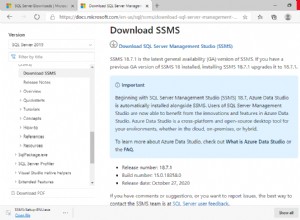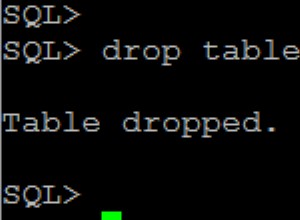select t1.ts as hival, t2.ts as loval
from metdata t1, metdata t2
where t2.ts = (select max(ts) from metdata t3
where t3.ts < t1.ts)
and not timediff(t1.ts, t2.ts) = '00:10:00'
To zapytanie zwróci kuplety, których możesz użyć do wybrania brakujących danych. Brakujące dane będą miały sygnaturę czasową między hival i loval dla każdego dwuwiersza zwróconego przez zapytanie.
EDIT - dzięki za sprawdzenie, Craig
EDYCJA2:
pobranie brakujących znaczników czasu — ten kod SQL staje się nieco trudniejszy do odczytania, więc trochę go podzielę. Po pierwsze, potrzebujemy sposobu na obliczenie serii wartości znaczników czasu między daną niską a wysoką wartością w odstępach 10-minutowych. Sposobem na zrobienie tego, gdy nie możesz tworzyć tabel, jest następujący sql, który tworzy jako zbiór wyników wszystkie cyfry od 0 do 9.
select d1.* from
(select 1 as digit
union select 2
union select 3
union select 4
union select 5
union select 6
union select 7
union select 8
union select 9
union select 0
) as d1
...teraz łącząc tę tabelę z kopią jej kilka razy, możemy dynamicznie generować listę o określonej długości
select curdate() +
INTERVAL (d1.digit * 100 + d2.digit * 10 + d3.digit) * 10 MINUTE
as date
from (select 1 as digit
union select 2
union select 3
union select 4
union select 5
union select 6
union select 7
union select 8
union select 9
union select 0
) as d1
join
(select 1 as digit
union select 2
union select 3
union select 4
union select 5
union select 6
union select 7
union select 8
union select 9
union select 0
) as d2
join
(select 1 as digit
union select 2
union select 3
union select 4
union select 5
union select 6
union select 7
union select 8
union select 9
union select 0
) as d3
where (d1.digit * 100 + d2.digit * 10 + d3.digit) between 1 and 42
order by 1
... teraz ten fragment sql zbliża się do tego, czego potrzebujemy. Ma 2 zmienne wejściowe:
- początkowy znacznik czasu (w przykładzie użyłem curdate()); i
- liczba iteracji - klauzula gdzie określa 42 iteracje w przykładzie, maksymalnie przy 3 x cyfrowych tabelach jest 1000 interwałów
... co oznacza, że możemy użyć oryginalnego sql do prowadzenia powyższego przykładu w celu wygenerowania serii znaczników czasu dla każdej pary hival lowval. Wytrzymaj, ten sql jest teraz trochę długi...
select daterange.loval + INTERVAL (d1.digit * 100 + d2.digit * 10 + d3.digit) * 10 MINUTE as date
from
(select t1.ts as hival, t2.ts as loval
from metdata t1, metdata t2
where t2.ts = (select max(ts) from metdata t3
where t3.ts < t1.ts)
and not timediff(t1.ts, t2.ts) = '00:10:00'
) as daterange
join
(select 1 as digit
union select 2
union select 3
union select 4
union select 5
union select 6
union select 7
union select 8
union select 9
union select 0
) as d1
join
(select 1 as digit
union select 2
union select 3
union select 4
union select 5
union select 6
union select 7
union select 8
union select 9
union select 0
) as d2
join
(select 1 as digit
union select 2
union select 3
union select 4
union select 5
union select 6
union select 7
union select 8
union select 9
union select 0
) as d3
where (d1.digit * 100 + d2.digit * 10 + d3.digit) between 1 and
round((time_to_sec(timediff(hival, loval))-600) /600)
order by 1
...teraz jest trochę epickiego sql
UWAGA:użycie tablicy cyfr 3 razy daje maksymalną lukę, którą pokryje nieco ponad 6 dni




